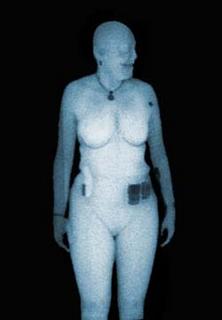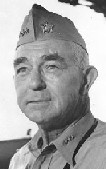Does This Mean They Get Hazardous Duty Pay?
 Security officials at Phoenix's Sky Harbor airport, home base of my favorite Pittsburgh near-monopoly, U.S. Airways, will be the first in the nation to try out backscatter x-ray machines as part of the passenger screening process. These machines use low level x-rays to see through clothing. Solid objects that are being hidden underneath the passengers' clothing -- including guns, bombs, drugs, and toothpaste containers that exceed 4 ounces in capacity -- will be clearly visible. As a bonus, the screeners will finally get to achieve the dream of every 11-year-old boy and see what people look like naked beneath their clothes! After all those years of false promises from those x-ray glasses advertisements in magazines, the real thing is finally in reach.
Security officials at Phoenix's Sky Harbor airport, home base of my favorite Pittsburgh near-monopoly, U.S. Airways, will be the first in the nation to try out backscatter x-ray machines as part of the passenger screening process. These machines use low level x-rays to see through clothing. Solid objects that are being hidden underneath the passengers' clothing -- including guns, bombs, drugs, and toothpaste containers that exceed 4 ounces in capacity -- will be clearly visible. As a bonus, the screeners will finally get to achieve the dream of every 11-year-old boy and see what people look like naked beneath their clothes! After all those years of false promises from those x-ray glasses advertisements in magazines, the real thing is finally in reach.
Just how detailed are these pictures? Not bad. I mean sure, it's not centerfold-quality by any means, but there certainly is very little mystery once someone steps up to the backscatter machine. The images are clear enough to keep both Beavis and Butthead entertained for at least the next decade, if not more: After the machines are tested out in Phoenix, they will be expanded to other airports as part of a pilot program. Eventually, they may end up in airports across the country, including such teaming transportation hubs as Venango County's Franklin Regional airport and Latrobe's Arnold Palmer airport. Trust me, I've seen the poor bored bastards who work as screeners at these airports. If anyone ever deserved access to this kind of technology, just to add some marginal degree of interest to an oppressively monotonous workday, it's these guys.
After the machines are tested out in Phoenix, they will be expanded to other airports as part of a pilot program. Eventually, they may end up in airports across the country, including such teaming transportation hubs as Venango County's Franklin Regional airport and Latrobe's Arnold Palmer airport. Trust me, I've seen the poor bored bastards who work as screeners at these airports. If anyone ever deserved access to this kind of technology, just to add some marginal degree of interest to an oppressively monotonous workday, it's these guys.
Oddly enough, and despite my libertarian bent, I don't really have any visceral reaction against the use of these machines. The current screening process, after all, already requires me to remove so much of what I'm wearing that backscatter x-ray machines will make very little difference. But I am enormously worried about the mental and occular health of those assigned to work the backscatter machines once they arrive in our region.
It's not that have don't have attractive and beautiful, even totally hot, people here in Pittsburgh. We do pretty well in that department, at least as well as other cities. But the rest of us -- the large majority who do not fall into that those categories -- are hardly the stuff of anybody's dreams. Is there anyone, for example, who really wants to see Darlene Harris naked? And when it comes to the truly disgusting, the ones who require seatbelt extenders on the airplane and who are sometimes asked to purchase an additional seat to accomodate their girth, Pittsburgh seems to have a nearly inexhaustible supply.
I've been in countless screening lines at Pittsburgh International, and I've seen what the screeners there will have to work with. Just a few hours on the backscatter machine at our airport would be enough to make even the most hardened nervous system shut down any signals coming from visual stimuli and trigger a compassionate case of hysterical blindness. I just hope that the TSA does what it can to protect their employees.
An even more worrying aspect of the TSA's plans for using these machines is that they don't seem likely to produce any real increase in security. The TSA seems so overwhelmingly concerned about privacy issues that most of the benefits that could come from using backscatter technology are being erased. For example, the machines will only be used as a tool in "secondary screening", meaning that we will still need to go through all the painful rituals of the current "primary screening" procedure, removing our belts, shoes, jackets, coats, sweaters, and sweatshits. Even then, the small minority of passengers who are selected for "secondary screening" will have the option of getting a pat-down search instead of a session at the backscatter machine.
To further protect our privacy, the TSA is taking pains to install these devices away from other passengers. So if you are selected for secondary screening, you will have to walk to some remote part of the screening area for your backscatter x-ray. Since that walk (there and back) will just waste more of your time, opting for a "then and there" pat-down search will probably make far more sense.
Even if you do decide to walk over to the backscatter machine, the TSA's procedures dictate that the screener who is there with you will not be able to see any of the images. Instead, they will be transmitted to a remote office where a different screener can view them. So, assuming that they detect anything really dangerous, such as a 4.2 oz. gel deodorant, the two screeners will have to engage is some kind of bizarre back-and-forth conversation about where the offending article is being hidden. Ultimately, the screener who took you to the backscatter machine will have to do a "pat-down" search anyway to locate and confiscate it.
Given these procedures, what's the point? It sounds like backscatter x-ray could be really useful in so many ways, but the way that the TSA is employing it is just plain stupid. They have spent untold millions developing these machines. Then millions more on figuring out who to blur out the naughty bits of the images to protect our prudish fear of being seen naked. Then they will shell out even more our our tax money to purchase, deliver, and install these devices, along with a bunch more for training.
At the end of the day, the only benefits seem to be a few less pat-down searches of those who have been selected for "secondary screening". And even that may not be much of a benefit. If a single screener can do a pat-down search in 30 seconds or so, how is it cost-effective to spend 20 seconds walking the passenger over to the distant machine, another 10-15 seconds getting them set up in front of it, then involve two screeners in (I'm guessing here) a 30-second scanning process while the two TSA people talk back and forth, followed by another 20-second walk back to the main part of the security area? Look, if they are going to spend all of those tax dollars and develop a machine that many people believe to be at least a marginal invasion of privacy, they least they can do is employ it in such a way that it will actually do some good. If backscatter x-rays are going to be used, then I want them used like the subway-station scanners in Arnold Schwarzenegger's movie about Mars, Total Recall. Scan every single person with it as they walk by, eliminating the need for us to strip down for primary screening. That will at least save us all a bit of time, and may even (although I have my doubts) make us a bit more safe in the air.
Look, if they are going to spend all of those tax dollars and develop a machine that many people believe to be at least a marginal invasion of privacy, they least they can do is employ it in such a way that it will actually do some good. If backscatter x-rays are going to be used, then I want them used like the subway-station scanners in Arnold Schwarzenegger's movie about Mars, Total Recall. Scan every single person with it as they walk by, eliminating the need for us to strip down for primary screening. That will at least save us all a bit of time, and may even (although I have my doubts) make us a bit more safe in the air.

No comments:
Post a Comment